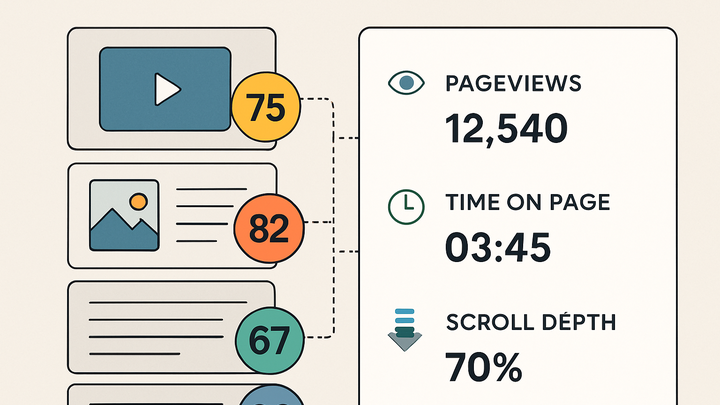Published on 2025-06-22T07:09:56Z
What is Content Scoring? Examples for Content Scoring.
Content Scoring is a systematic approach to quantify the performance of content based on engagement metrics and user behavior. It enables marketers, content creators, and analysts to assign numeric values that reflect how well each piece of content resonates with the audience. By weighting metrics such as pageviews, time on page, scroll depth, social shares, and conversions, you can compare and rank blog posts, landing pages, videos, and more. Content scoring facilitates data-driven decisions by highlighting which assets drive the most value, allowing you to optimize your content strategy and allocate resources effectively. In analytics platforms like PlainSignal (a cookie-free analytics solution) and Google Analytics 4 (GA4), you can implement content scoring by defining custom metrics or events, capturing relevant data points, and applying a scoring model that suits your goals.
Content scoring
Assign numeric values to content based on engagement metrics like pageviews, time on page, and conversions for data-driven strategy optimization.
Key Components of Content Scoring
A robust content scoring model relies on three main components: selecting relevant metrics, assigning appropriate weights, and aggregating the results into a final score. Each component must align with your business objectives and reflect what ‘success’ means for your content.
-
Metrics selection
Choose the user interactions and performance indicators that best represent engagement for your content.
-
Pageviews
The total number of times a page is viewed. Indicates popularity.
-
Time on page
Average duration users spend on a page. Signals depth of engagement.
-
Scroll depth
Percentage of page scrolled. Helps measure content consumption.
-
Conversions
Actions like sign-ups or downloads. Reflects content ROI.
-
-
Weight assignment
Assign importance to each metric based on strategic priorities. For example, conversions may weigh more than pageviews if lead generation is a key goal.
-
Score aggregation
Combine weighted metrics into a single score using a formula. Normalize scores to a consistent scale (e.g., 0–100).
Benefits of Using Content Scoring
Content scoring transforms raw engagement data into actionable insights, enabling teams to prioritize and optimize their content library effectively.
-
Prioritize high-value content
Identify top-performing assets that drive engagement and conversions to replicate their success.
-
Optimize content strategy
Spot underperforming pieces early and adjust topics, formats, or promotion tactics accordingly.
-
Allocate resources efficiently
Focus time and budget on content with the highest potential impact.
Implementation Examples
Below are code examples demonstrating how to implement content scoring in PlainSignal and GA4.
-
PlainSignal setup
Use PlainSignal’s cookie-free analytics to track custom events and calculate scores. First, include the tracking snippet:
<link rel="preconnect" href="//eu.plainsignal.com/" crossorigin /> <script defer data-do="yourwebsitedomain.com" data-id="0GQV1xmtzQQ" data-api="//eu.plainsignal.com" src="//cdn.plainsignal.com/plainsignal-min.js"></script>Then, send a custom event with a score value:
ps('track', 'content_score', { content_id: 'blog-post-123', score: 85 }); -
Google analytics 4 (GA4) setup
In GA4, use custom events and metrics to capture content scores. Include the GA4 base snippet:
<script async src="https://www.googletagmanager.com/gtag/js?id=G-XXXXXXX"></script> <script> window.dataLayer = window.dataLayer || []; function gtag(){dataLayer.push(arguments);} gtag('js', new Date()); gtag('config', 'G-XXXXXXX'); </script>Then, log a content_score event:
gtag('event', 'content_score', { event_label: 'landing-page-5', value: 72 });
Best Practices for Content Scoring
To maintain a reliable content scoring system, follow these guidelines:
-
Align scores with goals
Ensure metric selection and weights reflect your specific business objectives.
-
Review and adjust regularly
Periodically revisit your scoring model to accommodate new data insights or strategy shifts.
-
Keep the model simple
Avoid overly complex formulas that are difficult to interpret or maintain.
Related Analytics Concepts
Content scoring intersects with several other analytics techniques:
-
Engagement scoring
Broader scoring model encompassing user-level interactions across all digital touchpoints.
-
Lead scoring
Assigns values to leads based on their behavior and demographics to predict conversion likelihood.
-
Behavioral analytics
Analysis of user behavior to understand patterns, preferences, and pain points.
